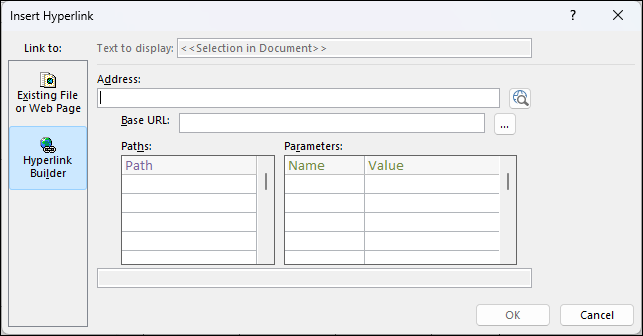|
|
Use the Edge Browser Control to specify a URL and show web pages on a form. You can map Access fields to URL parameters and create dynamic web pages for each form record. you can also browse files and folders by specifying a file URL.
Add an Edge Browser Control to a form
Change the position and size of the Edge Browser Control
Add an Edge Browser Control to a form
Adding an Edge Browser Control to a form is similar to other controls, except that the control source is a URL.
-
In the Navigation Pane, right click the form to which you want to add an Edge Browser Control, and then select Layout View.
-
On the Form Design tab, in the Controls group, select Edge Browser Control
-
Position the pointer where you want the control, and then click to place it. Access opens the Insert Hyperlink dialog box.
-
Do one of the following:
Add a simple URL
You want the same web page to display for each record in the form. For example, the Web page is a help site or supplementary information for the user.
-
Select Browse the Web to the right of the Address box.
-
When the page you want is displayed in your browser, copy the URL from the address bar, and then close the browser.
-
In the Insert Hyperlink dialog box, select OK.
Add a URL with a query string
You want to display a different web page for each record in the form. You can use a Query string which assigns values to parameters. For example, the Web page is a map that varies based on address fields in each record.
-
Select Browse the Web to the right of the Address box.
-
In your Web browser, navigate to the page you want displayed in the control.
-
In the Insert Hyperlink dialog box, paste the URL into the Address box, and then press the TAB key.
Access clears the Address box, and separates (or parses) the URL into the appropriate boxes: Base URL, Paths, and Parameters. The complete URL is displayed in a box below the Paths and Parameters lists.
-
To set the Edge Browser Control so that its URL changes based on the data that is displayed on your form, replace the appropriate URL components with expressions that refer to the appropriate controls on the form. For each component that you want to replace:
-
Click the path or parameter that you want to replace, and then click the Build button
-
In the Expression Builder dialog box, if the element lists are not displayed, click More >> to display them.
-
In the element lists, find the control that contains the data you want to be substituted for that path or parameter, and then double-click it to add it to the expression box.
-
If there are any other calculations that must be done with the value, add the necessary operators and expression elements, and then click OK to close the Expression Builder.
For more information about creating an expression, see Use Access expressions.
-
-
In the Insert Hyperlink dialog box, select OK.
-
You can also type the base URL, paths, and parameters directly into the boxes. For more information about creating Bing maps, see Bing Maps Documentation.
Navigating to Local Files
If you want to navigate to a local file instead of a web page, you must use the https://msaccess prefix before the file path in the address. For example: https://msaccess/C:\Users\user\Documents\test.html
Note: Navigation between webpages and local pages is not permitted in either direction.
Trusted Domains Property
By default, navigation via links and automatic redirects away from the page the browser currently shows are blocked. In order to allow these navigations, you can specify a table name or query name in the Trusted Domains property in the Property Sheet. In this case the table or query's first output column must contain the URLs that you want to allow the browser to link to and automatically redirect to. This is especially helpful for pages that automatically redirect to a login page that doesn't exist on the same domain.
Change the position and size of the Edge Browser Control
When you first place the Edge Browser Control on a form, it might occupy a fairly small cell in a layout. In most cases, you will need to adjust the layout to show as much of the Web page as possible. A good way to get started is to merge the cell that contains the control with adjacent empty cells:
-
Select the cell that contains the Edge Browser Control.
-
Hold down the CTRL key and select any empty adjacent cells that you want the control to occupy.
-
On the Arrange tab, in the Merge / Split group, click Merge.
-
Resize the resulting cell by selecting it and dragging its edges until it is the size you want.
Modify the control source of an Edge Browser Control
After adding an Edge Browser Control to a form, you might need to make further modifications to its control source (URL). Use the following procedure to open the Insert Hyperlink dialog box so that you can make changes.
-
In the Navigation Pane, right click the form to that contains the Edge Browser Control, and then click Layout View.
-
Select the Edge Browser Control, and then click Form Layout Design > Property Sheet in the Tools group.
-
On the All or Data tab in the property sheet, select the Control Source property and then click the Build button
-
In the Insert Hyperlink dialog box, make the necessary changes to the URL components, and then click OK.
Review the Edge Browser Control's object model
To learn about all the object model properties for the Edge Browser Contol, see EdgeBrowserControl object (Access)














